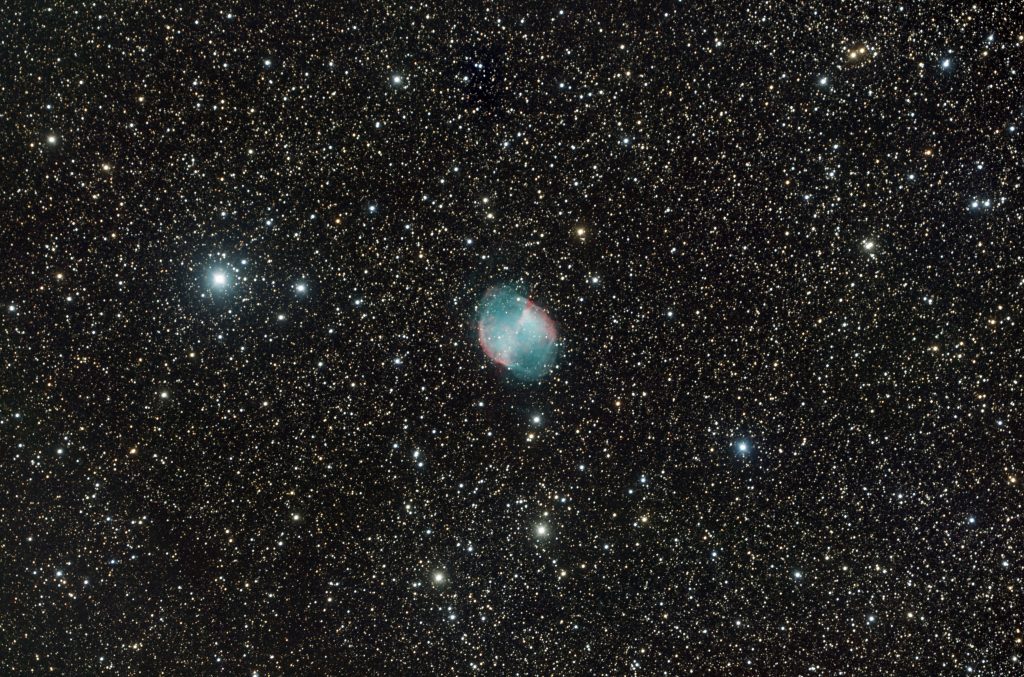
In the lesser-known constellation of Vulpecula, the fox, lie the well-known remains of a small, sun-like star that perished fairly recently, at least on cosmic timescales – the Dumbbell Nebula. Shorter exposure photographs usually only capture the brighter lobes of gas, helping to give rise to the name. The nebula was also the 27th entry of Charles Messier’s list of non-cometary objects, so it is commonly referred to as M27. Another fun moniker is the Apple Core Nebula since the two conically-shaped lobes glow prominently in red thanks to hydrogen gas, giving the appearance of a discarded apple core. Much of the inner blue-green glow of the nebula is due to emission from ionized oxygen atoms.
Taken with a ZWO ASI6200MC camera and 16″ astrograph telescope at Dyer Observatory, the featured wide-field image spans nearly the width of three full Moons and is comprised of 180 two-minute exposures digitally added together for an effective exposure of six hours. The field of view is littered with nearly 20,000 stars, which is no surprise given M27 appears against the band of our Milky Way galaxy where we find the highest stellar concentration. With this and the obscuring effects from dust that pervade a spiral galaxy such as ours, it is uncommon to also catch glimpses of distant galaxies when observing through the plane of our home galaxy.
The Dumbbell Nebula is a prime example of a planetary nebula. It was first noted by Charles Messier in 1764, making it the first object of its kind to be discovered. The term was coined by astronomer William Herschel after noting that these nebulous, often circular objects somewhat resembled the outer planets. In reality, they have nothing to do with planets and are the final result of small stars expelling their outer layers into space, exposing the white hot cores that cause the expanding gas to fluoresce. This will be the fate of our own Sun in about five billion years or so.
The core of a small, dead star (known as a white dwarf) is essentially just a white-hot ember that no longer produces energy through fusion processes like a typical star. Instead, it is very slowly radiating away its energy, a process that takes billions of years. This core is a ball of degenerate matter, mostly carbon and oxygen, that has collapsed down as much as it can under the force of gravity. As such, it is extremely dense – a baseball made of typical white dwarf matter on Earth would weigh a bit more than a blue whale. M27’s white dwarf is estimated to have a mass about half that of the Sun (about 160,000 Earth masses) crammed into a ball about 5-6 times the diameter of our planet. Though fantastic, this is a bit of an anomaly as white dwarfs with this mass are typically even smaller, usually only about the size of Earth.
The Dumbbell nebula lies about 1,300 light-years away. An apparent size of one-fourth the Moon on the sky equates to a true physical size of approximately two light-years in width (or roughly 2,000 times the width of Neptune’s orbit). The gas within the nebula continues to expand outwards, and its velocity can be measured by the Doppler shift in the emitted light. This allows astronomers to essentially run the movie backwards to determine the nebula began forming about 10,000 years ago. As the nebula continues to expand away from the ultraviolet-emitting white dwarf, it will grow dimmer over thousands of years and eventually become invisible to the eye through a telescope.
But for now, the Apple Core Nebula is decently large and bright on the sky, making it visible in small telescopes and even in a good pair of binoculars. Though technically within the boundaries of the small constellation Vulpecula, it can be easily located with the help of the nearby constellation Cygnus, the swan. The five brightest stars of the constellation form a famous asterism known as the Northern Cross, and three of these stars (Sadr, Albireo, and Gienah) form the corners of a nearly perfect rectangle with M27. Need a little guidance? Be sure to check out the monthly sky chart and the figure below for help locating the it.
